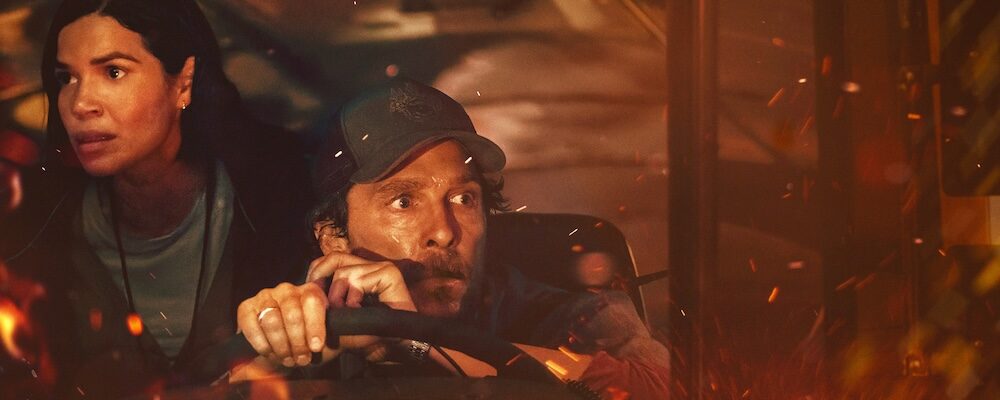‘The Lost Bus’: Matthew McConaughey Navigates a Group of Children Through a Raging Inferno in Real-Life Wildfire Drama
Tony Sokol
In 2018, the Camp Fire decimated the town of Paradise, CA. It was the deadliest wildfire in California history, killing 85 people, razing more than 150,000 acres, and displacing countless families. The blaze spread so quickly it was impossible to contain. “The Lost Bus” is an immersive ride-along into the darkest terrain of the catastrophe, from early warnings to fiery evacuations and chaotic rescues. Paul Greengrass, who directed “United 93” and “Captain Phillips,” delivers a different kind of disaster movie. Inspired by the 2021 book “Paradise: One Town’s Struggle to Survive an American Wildfire,” by Lizzie Johnson, co-screenwriters Greengrass and Brad Ingelsby tell two stories of a community’s environmental calamity: one on the ground, and the other in the flames themselves.
Matthew McConaughey plays Kevin McKay, one of the most reluctant and unlikely heroes of modern action cinema. This is partially due to authentic motivational ambiguity. When the school bus dispatcher, Ruby (Ashlie Atkinson), calls to ask whether anyone can take stranded kids to a safe place, Kevin really does not want to do it. Silently begging not to be the only empty bus in the area, he waits until the very last second before mumbling his availability. How he gets out of an impossible situation boggles the mind, especially in light of the deaths from the 2018 Camp Fire.
Even McConaughey can’t believably turn a state disaster into a personal redemption story. Kevin has too much on his plate for a real-life action film. Born in Paradise, Kevin skipped town at 16 to get away from a domineering father, and came back over 20 years later for his dad’s funeral. Kevin’s elderly and wheelchair-bound mother is sick, his teenage son, Shaun (Levi McConaughey, Matthew’s son), is loaded with attitude, and complains to Kevin’s ex-wife, who saves every grudge. Even Kevin’s beloved dog has to be put down. He drives the school bus to barely get by, keeping the job by the skin of his teeth, yet stubbornly avoids bringing the school bus back to the maintenance shed on time. Kevin’s self-imposed bad luck and occupational belligerence result in landing the responsibility of keeping bus 693 safely out of danger. Kevin sees the rescue as a chance to do something meaningful, ultimately. But he fights it as long as he can.
America Ferrera plays Mary Ludwig, the teacher assigned with transporting 22 elementary school students to the designated safety area where their parents are waiting. Mary has only been out of Paradise once in her life, and swears to change her sheltered ways once her responsibility to the children is done, if they get out of the fire alive. The journey to promised safety is wrought with incendiary detours. Each impromptu detour grows more harrowing than the prescribed routes, but increasingly become the more expedient choices. A loss of radio contact blocks news that the safety zone is burnt out, and the whole area is out of radio contact. The bus faces gridlock, armed rioters, and occasionally becomes surrounded by other vehicles bursting into flames with the ever-encroaching heat. No area is safe. Even while secluded in an unburnt patch offering a brief respite, the air quality remains unbreathable. Children lose consciousness, and Mary realistically weighs the options of letting the kids die of asphyxiation in their sleep over burning to death. It is not something the audience, nor Kevin, would ever expect from the obviously dedicated educator.
The cause of the unprecedented inferno is revealed at the start of the film: a faulty Pacific Gas & Electric high-tension power line sparked the fire, and a fierce wind spread it too fast for firefighters to get a handle on it. The fire itself is an ever-increasing and highly-evolving character. Full sequences follow events from the fire’s own point of view. Its relentless roar dominates the landscape, and even those trying to escape by desperately diving into a pond find no protection from the rudderless inferno. The CGI-augmented fire is neither overdone nor distracting.
Initially, and under reasonable circumstances, correctly believing the fire-fighting squad could “knock this out before it becomes something,” Cal Fire Battalion Chief Ray Martinez (Yul Vasquez) runs out of containment options. Without regard for camera angles, Vazquez remains in the moment at all time, always reacting to the unfolding chaos with no self-awareness. This is a man on the job, not someone playing someone going through the motions, even as very human panic sets in. The pain in Martinez’s voice is palpable as the orders are given to immediately change course from firefighting to lifesaving, as the fire is beyond control. Only one aside, at the press conference, lays a less-than-pointed finger at climate change. The neutrality screams loudly.
Greengrass pulls suspense from action and response. Each emotional reaction becomes a physical feat as the danger consistently overwhelms every rational expectation. But the constant motion keeps us on the edge of our seats. Hand-held cameras capture the immediacy, soot-covered windshields embody the chaos. The children’s reactions become a valve to contain the panic. Intercut with quick cuts to the waiting parents, expectations become intense. Yet, emotional distance and restraint keep “The Lost Bus” tight and terrifying. It’s scary enough trying to keep your eyes on the road.
“The Lost Bus” releases Sept. 19 in select theaters and Oct. 3 on Apple TV+.

